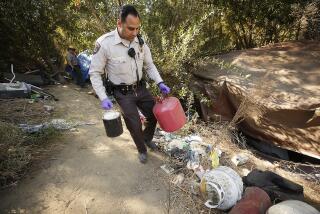L.A. Police Agree to Deploy More Officers in Minority Areas
Responding to pressure from minority groups, the Los Angeles Police Commission agreed Tuesday to adopt a new deployment formula that substantially increases the number of patrol officers in minority areas.
In a related development, Mayor Tom Bradley proposed adding 250 positions to the 7,500-officer department, boosting the police force to a record number of officers.
Assistant Police Chief Robert Vernon said residents would not see any “radical differences” in the number of officers in their neighborhoods as a result of the new formula because the department during the last two years has added more patrol officers to high-crime ethnic communities.
The commission’s unanimous vote ordering the department to adopt the new formula was hailed as a victory for black and Latino community groups, which had complained since 1984 that more officers were assigned to affluent, predominantly white neighborhoods than in impoverished, minority communities plagued by high rates of violent crime.
“It was a great victory for us,” said Gwen Cordova, spokeswoman for the South-Central Organizing Committee, a black community group that pushed for an independent study of the department’s deployment of officers. “We’re very pleased that the department is finally changing the deployment to give us more police we so desperately need.”
The commission’s decision to change the patrol formula came after Police Chief Daryl F. Gates and a commission subcommittee announced that they supported a new deployment formula proposed by an independent study.
The 10-month, $184,000 study ordered by the commission proposed last month that the department scrap its old formula and put 66% more patrol officers on the streets throughout the city to answer emergency calls, with the largest boosts in the high-crime minority areas.
The study criticized the department for putting too many officers into special task forces and for having too many delays in responses to emergency calls.
The report suggested as an interim goal an average response time of seven minutes, a proposal that was embraced by commissioners and Gates. Vernon said the department hopes to reach the goal by mid-1989.
Gates had said earlier that he had already revised the controversial formula, but he refused to say how. The chief had also said that he did not believe that the report would result in any drastic changes in his department.
Bradley made an appearance at the commission meeting to announce that he would include in his proposed 1988-89 budget the addition of 250 officers to the force, boosting it to an all-time high of 7,750 officers.
Bradley said the first year’s cost of the additional officers would be $16.6 million. He said he would propose paying for the increase with money from the city’s share of a federal fund of drug dealers’ confiscated property.
Annual costs thereafter would be $26.4 million.
“You have here unanimity that would not have been predicted four years ago,” Bradley said, referring to wrangling between officials and community organizations that have long claimed there were inequities in police deployment in poor areas of the city.
The mayor said city officials were “determined to take back the streets of Los Angeles” from gangs.
Vernon said the department, which is in the process of hiring 358 new officers as part of an ongoing police expansion program, will put the new officers on patrol, as recommended by the study.
Vernon said the new formula and the addition of the 358 new officers will mean increasing the number of patrol officers from 2,349 to 2,707.
More to Read
Sign up for Essential California
The most important California stories and recommendations in your inbox every morning.
You may occasionally receive promotional content from the Los Angeles Times.










